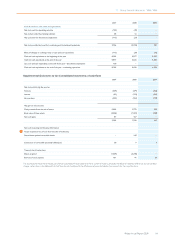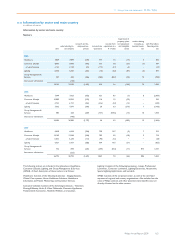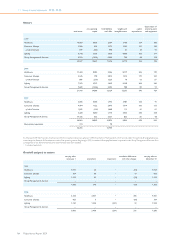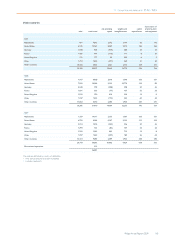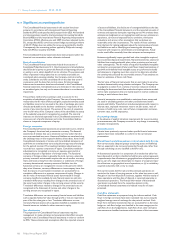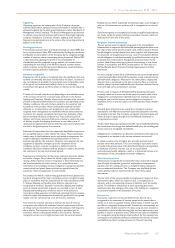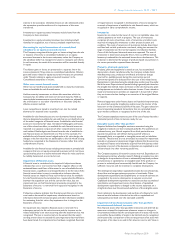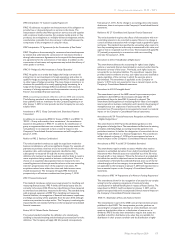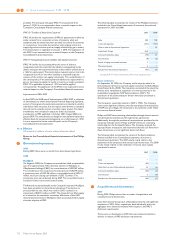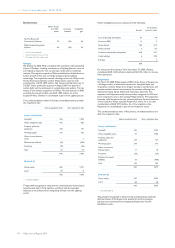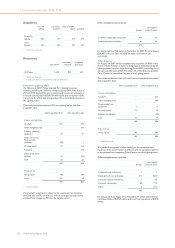Philips 2009 Annual Report Download - page 168
Download and view the complete annual report
Please find page 168 of the 2009 Philips annual report below. You can navigate through the pages in the report by either clicking on the pages listed below, or by using the keyword search tool below to find specific information within the annual report.
purposes. Deferred tax is not recognized for the following temporary
differences: the initial recognition of goodwill, the initial recognition of
assets and liabilities in a transaction that is not a business combination
and that affects neither accounting nor taxable profit, and differences
relating to investments in subsidiaries to the extent that they probably
will not reverse in the foreseeable future. Measurement of deferred tax
assets and liabilities is based upon the enacted or substantially enacted
tax rates expected to apply to taxable income in the years in which
those temporary differences are expected to be recovered or settled.
Deferred tax assets, including assets arising from loss carry-forwards,
are recognized if it is probable that the asset will be realized. Deferred
tax assets are reviewed each reporting date and reduced to the extent
that it is no longer probable that sufficient taxable income will be
available to allow all or part of the asset to be recovered. Deferred tax
assets and liabilities are not discounted.
Deferred tax liabilities for withholding taxes are recognized for
subsidiaries in situations where the income is to be paid out as dividend
in the foreseeable future, and for undistributed earnings of
unconsolidated companies to the extent that these withholding taxes
are not expected to be refundable or deductible. Changes in tax rates
are reflected in the period when the change has been enacted or
substantively enacted by the reporting date.
Leases
Leases in which a significant portion of the risks and rewards of
ownership are retained by the lessor are classified as operating leases.
Payments made under operating leases are recognized in the
Statements of income on a straight-line basis over the term of the lease.
Leases in which the Company has substantially all the risks and rewards
of ownership are classified as finance leases. Finance leases are
capitalized at the lease’s commencement at the lower of the fair value of
the leased assets and the present value of the minimum lease payments.
Each lease payment is allocated between the liability and finance charges
so as to achieve a constant rate of interest on the finance balance
outstanding. The corresponding rental obligations, net of finance
charges, are included in other short-term and other non-current
liabilities. The property, plant and equipment acquired under finance
leases is depreciated over the shorter of the useful life of the assets and
the lease term.
Derivative financial instruments
The Company uses derivative financial instruments principally to
manage its foreign currency risks and, to a more limited extent, for
managing interest rate and commodity price risks. All derivative
financial instruments are classified as current assets or liabilities based
on their maturity dates and are accounted for at trade date. Embedded
derivatives are separated from the host contract and accounted for
separately if required by IAS 39 Financial Instruments: Recognition and
Measurement. The Company measures all derivative financial
instruments based on fair values derived from market prices of the
instruments or from option pricing models, as appropriate. Gains or
losses arising from changes in fair value of derivatives are recognized in
the statement of income, except for derivatives that are highly effective
and qualify for cash flow or net investment hedge accounting.
Changes in the fair value of a derivative that is highly effective and that is
designated and qualifies as a fair value hedge, along with the loss or gain
on the hedged asset, or liability or unrecognized firm commitment of
the hedged item that is attributable to the hedged risk, are recorded in
the statement of income.
Changes in the fair value of a derivative that is highly effective and that is
designated and qualifies as a cash flow hedge, are recorded in equity,
until statement of income is affected by the variability in cash flows of
the designated hedged item. To the extent that the hedge is ineffective,
changes in the fair value are recognized in the statement of income.
The Company formally assesses, both at the hedge’s inception and on an
ongoing basis, whether the derivatives that are used in hedging
transactions are highly effective in offsetting changes in fair values or
cash flows of hedged items. When it is established that a derivative is
not highly effective as a hedge or that it has ceased to be a highly
effective hedge, the Company discontinues hedge accounting
prospectively. When hedge accounting is discontinued because it has
been established that the derivative no longer qualifies as an effective
fair value hedge, the Company continues to carry the derivative on the
balance sheet at its fair value, and no longer adjusts the hedged asset or
liability for changes in fair value.
When hedge accounting is discontinued because it is expected that a
forecasted transaction will not occur, the Company continues to carry
the derivative on the Balance sheet at its fair value, and gains and losses
that were accumulated in equity are recognized immediately in the
Statement of income. If there is a delay and it is expected that the
transaction will still occur, the amount in equity remains there until the
forecasted transaction affects income. In all other situations in which
hedge accounting is discontinued, the Company continues to carry the
derivative at its fair value on the Balance sheet, and recognizes any
changes in its fair value in the Statements of income. For interest rate
swaps designated as a fair value hedge of an interest bearing asset or
liability that are unwound, the amount of the fair value adjustment to the
asset or liability for the risk being hedged is released to the Statement of
income over the remaining life of the asset or liability based on the
recalculated effective yield.
Foreign currency differences arising on the retranslation of a financial
liability designated as a hedge of a net investment in a foreign operation
are recognized directly as a separate component of equity, to the extent
that the hedge is effective. To the extent that the hedge is ineffective,
such differences are recognized in the Statements of income.
Non-derivative financial instruments
Non-derivative financial instruments are recognized initially at fair value
when the Company becomes a party to the contractual provisions of
the instrument. They are derecognized if the Company’s contractual
rights to the cash flows from the financial instruments expire or if the
Company transfers the financial instruments to another party without
retaining control or substantially all risks and rewards of the
instruments. Regular way purchases and sales of financial instruments
are accounted for at trade date. Dividend and interest income are
recognized when earned. Gains or losses, if any, are recorded in
financial income and expenses.
Cash and cash equivalents
Cash and cash equivalents include all cash balances and short-term
highly liquid investments with an original maturity of three months or
less that are readily convertible into known amounts of cash. They are
stated at face value, which approximates fair value.
Receivables
Trade accounts receivable are carried at the lower of amortized cost or
the present value of estimated future cash flows, taking into account
discounts given or agreed. The present value of estimated future cash
flows is determined through the use of allowances for uncollectible
amounts. As soon as individual trade accounts receivable can no longer
be collected in the normal way and are expected to result in a loss, they
are designated as doubtful trade accounts receivable and valued at the
expected collectible amounts. They are written off when they are
deemed to be uncollectible because of bankruptcy or other forms of
receivership of the debtors. The allowance for the risk of non-
collection of trade accounts receivable takes into account credit-risk
concentration, collective debt risk based on average historical losses,
and specific circumstances such as serious adverse economic conditions
in a specific country or region.
In the event of sale of receivables and factoring, the Company
derecognizes receivables when the Company has given up control or
continuing involvement.
Long-term receivables are initially recognized at their present value
using an appropriate interest rate. Any discount is amortized to income
over the life of the receivable using the effective yield.
Investments in equity-accounted investees
Investments in companies in which the Company does not have the
ability to directly or indirectly control the financial and operating
decisions, but does possess the ability to exercise significant influence,
are accounted for using the equity method. Generally, in the absence of
demonstrable proof of significant influence, it is presumed to exist if at
least 20% of the voting stock is owned. The Company’s share of the net
income of these companies is included in results relating to equity-
accounted investees in the Consolidated statements of income. When
the Company’s share of losses exceeds its interest in an equity-
accounted investee, the carrying amount of that interest (including any
long-term loans) is reduced to nil and recognition of further losses is
discontinued except to the extent that the Company has incurred legal
or constructive obligations or made payments on behalf of an associate.
Unrealized gains on transactions between the Company and its equity-
accounted investees are eliminated to the extent of the Company’s
11 Group financial statements 11.11 - 11.11
168 Philips Annual Report 2009





